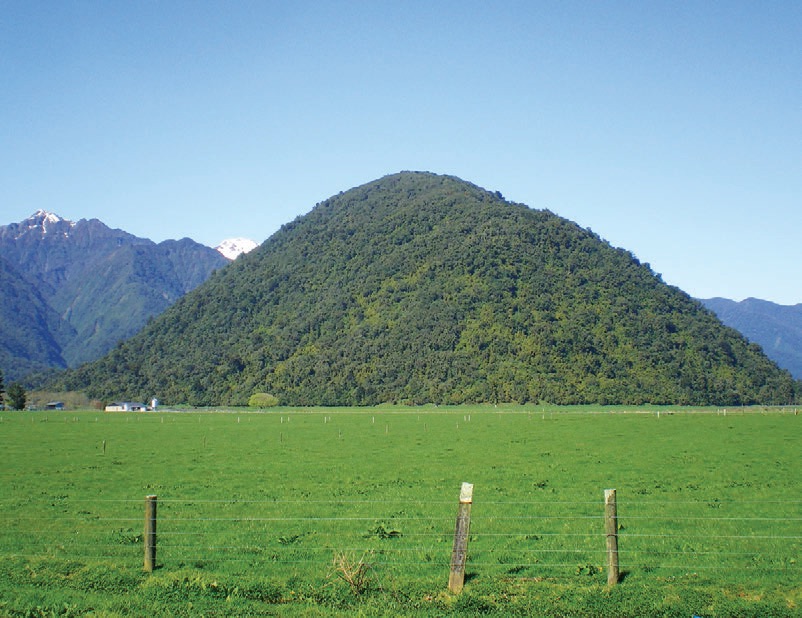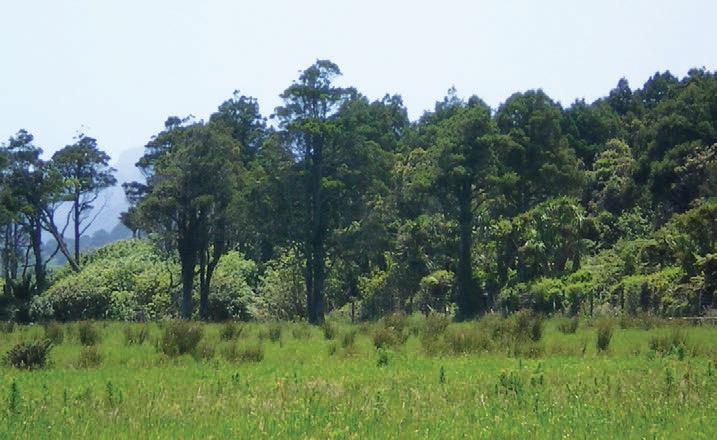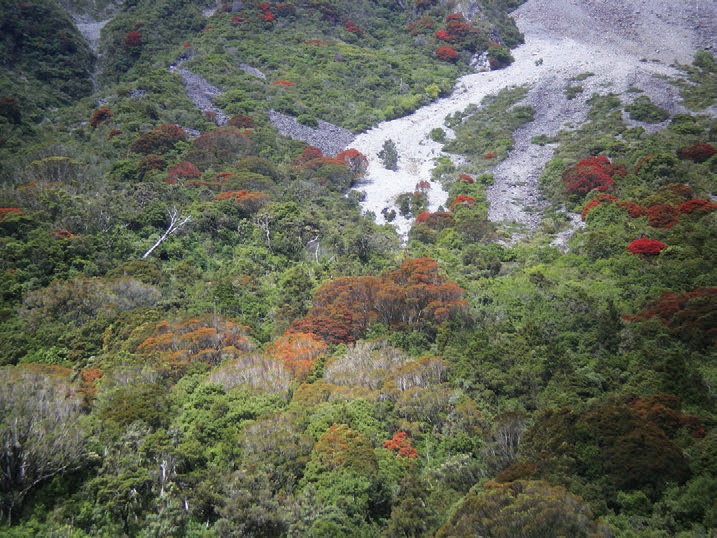A physical description of the West Coast
David Eastwood, New Zealand Tree Grower May 2010.
The West Coast of the South Island is a distinctive region of New Zealand with unique geological, climatic, vegetation and social characteristics. It lies between 41 and 44 degrees south and is bounded to the east by the Southern Alps.
Geographically this area extends 650 km from Kahurangi Point in the north to Big Bay in the south. It covers 2.3 million hectares and is administered by three District Councils − Buller in the north, centred on Westport, Grey, covering Greymouth, the Grey Valley and central areas with Westland, based in Hokitika. The West Coast Regional Council administers coastal zones and issues, land and riverbeds, water quality and use, regional plans and other aspects of the whole of the geographic area.
Geology
Some of New Zealand’s oldest rocks and some of the country’s youngest landscapes are found on the West Coast. The region is still geologically active with two giant tectonic plates in motion deep below ground. The boundary of these two plates shows on the ground surface as the Alpine Fault which runs the full length of the West Coast. It divides the coast into two distinct geological sections.
East of the fault the Southern Alps are still rising as the Pacific plate rides up over the Indo-Australian plate. The rocks here are mostly schist, a sedimentary rock which has been so altered from its original composition by the heat and pressure of the uplift that it is now called a metamorphic rock.
Long ago small pockets of volcanic rock were forced up into the schist and these have also been metamorphosed to serpentine and nephrite.The latter is the hard and beautiful pounamu or greenstone and the basis of the modern greenstone industry.
Further east of the fault the degree of metamorphism decreases. By the time the crest of the Southern Alps is reached the rocks remain as the original hard greywacke and argillite sediments, sometimes with seashell fossils, from which the schists were made.
More recent influences on the landscape have been the great ice sheets and glaciers of the ice age. A series of ice advances and retreats from the Southern Alps between 250,000 and 10,000 years ago severely eroded the alpine country and coastal hills, re-depositing the material as large hilly moraines or as flat outwash terraces on top of the coastal lowlands.

Ice reached its most recent maximum extent about 20,000 years ago with ice well out to sea over much of the West Coast. Later and smaller ice advances left lower deposits and ice trapped behind terminal moraines, which melted to leave lakes.
The most recent influences have been those of earthquakes, erosion in the high country, and flood borne silt deposition in the valleys. The latter has been particularly important as it has been the only source of fertile soils on the West Coast.
Climate and soils
Weather on the West Coast is quite different from the rest of the country. Tropical warm cyclones which affect Northland and the East Cape do not reach the West Coast. The southerlies which bring rain and cold weather from the southern ocean to Canterbury and Dunedin bring cold, dry and often sunny weather to the West Coast, under the protection of the Southern Alps.
West Coast weather patterns change frequently. The most common blustery wind flow is from the west and north west, but northerlies are regular. They load up with water vapour while crossing the Tasman, and drop it on the west side of the Southern Alps, leaving the wind to gather speed and heat as it drops on to the plains as a Canterbury nor’wester.
Sea breezes are common near the coast especially in summer, and periodic tree and property damaging mini twisters can move up the big river mouths. Some alpine valleys experience very strong easterly or south-easterly winds, the ones most damaging to trees. Katabatic winds where cold winter air moves down valley after cloudless nights also occur locally, the best known being the Greymouth barber.
Temperatures do not reach extremes of either hot or cold, with the sea moderating the daily temperature variations of coastal locations. Frosts are not as severe or as frequent as in Canterbury.
Rain days are higher than most of the country, the reason for the wonderful rainforest tree species. The total rainfall increases as you move south − Karamea 1,825 mm, Westport 2,160 mm Hokitika 2,870mm and Haast 3,460 mm a year. Rainfall also increases inland − Greymouth 2,480 mm, Inchbonnie 4,550 mm and Otira 5,160 mm. Extended dry periods rarely occur, but when they do the high vegetation fuel loadings, can lead to extreme fire danger.
Vegetation
During the ice age forest was swept from the land, although pockets of beech forest survived in lowland sites in both northern and southern ends of the region. Studies of fossil pollen grains provide an idea of how the West Coast was revegetated as the ice retreated about 14,000 years ago.
Firstly only grasses and shrubs grew in what was still a cold, dry climate. About 10,000 years ago rainfall and temperatures increased and podocarp forest sprang up in the lowlands, with other podocarps and hardwoods in the mountains. About 5,000 years ago the rainfall and temperatures decreased again and beech began a major expansion into the podocarp forests from both and north and south. This spread appears to have stopped about 2,000 years ago.
The distribution of beech forests on theWest Coast is of major interest, with the complete absence of beech in both lowland and subalpine forests for 150 km between the Taramakau and Mahitahi Rivers.
Tussocks and a wide range of small flowering plants cover the mountain ranges today above about 1,000 metres, grading via a belt of cold-tolerant shrubs into forest below this altitude. A number of plants reach their southern limits on the West Coast. For example tanekaha is not found south of Westport, northern rata and the nikau palm are not found south of about Greymouth, and kawakawa reaches its limit at Okarito.
Soil and altitude effects
Soil conditions and altitude strongly influence the distribution of forests types, with totara, matai and red beech requiring well drained fertile soil, kahikatea occupying damper fertile soil, rimu tolerating infertile soil, silver pine and yellow silver pine poorly drained infertile soil, while pink pine, southern rata and silver beech tolerate cold, high altitude sites.

Podocarp forests, the main taller species being kahikatea, matai, totara, miro and rimu, are rich in understorey trees, tree ferns, vines, epiphytes, shrubs, ground ferns, grasses and mosses. Pure beech forests do not have such diverse combinations of other plants.
Possums and deer have killed off many understorey trees such as broadleaf, pigeonwood, mahoe and coprosmas. Possums have even killed whole canopy trees such as southern rata, kamahi and mountain totara.
Sustainable harvesting of the native sphagnum moss is practised through out the West Coast. Small areas of private sustainably managed native timber blocks are also harvested for fine heritage timbers.
Wildlife

For ornithologists and environmental managers, the West Coast is a veritable wildlife paradise. There is not space here to describe everything to be found, but many species come right into suburban gardens especially in winter and spring, and are a delight to all.
Forest dwelling birds encountered in out own forest growing areas include tui, bellbird, pigeon, fantail, tomtit, waxeyes, and grey warbler which are common, even in small remnant vegetation blocks.
The South Island robin and brown creeper are only found in large, undisturbed forest blocks. Kaka and parakeets are greatly reduced in numbers, but can still be seen in their favoured locations. Weka seem to be everywhere. Pukeko and paradise duck are widespread on farmland, with pied stilt, oystercatchers and spur-winged plovers regularly seen feeding in dairy paddocks.
Whitebait and other native fish rely on clean streams and good stream cover. West Coast planted forest areas and natural forests provide stable environmental habitats, and increasing attention is being given on farms to fencing off coastal spawning areas and streamside riparian areas.

 Farm Forestry New Zealand
Farm Forestry New Zealand